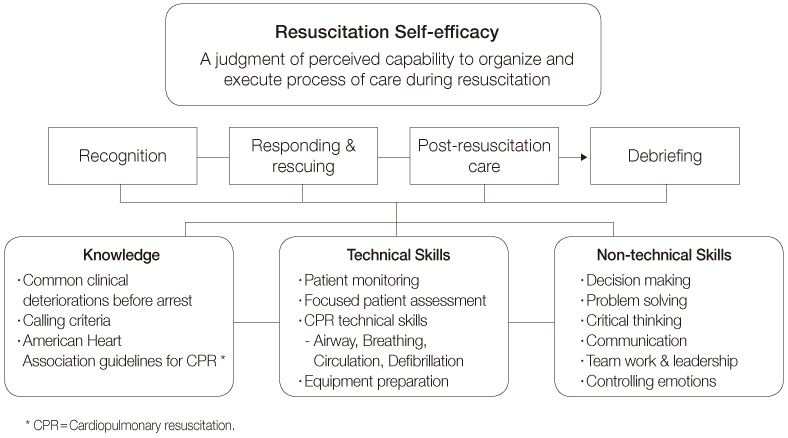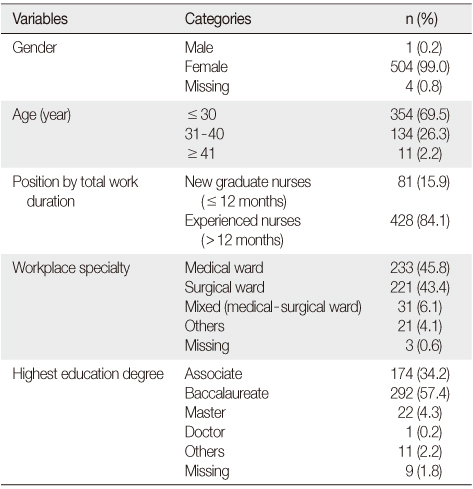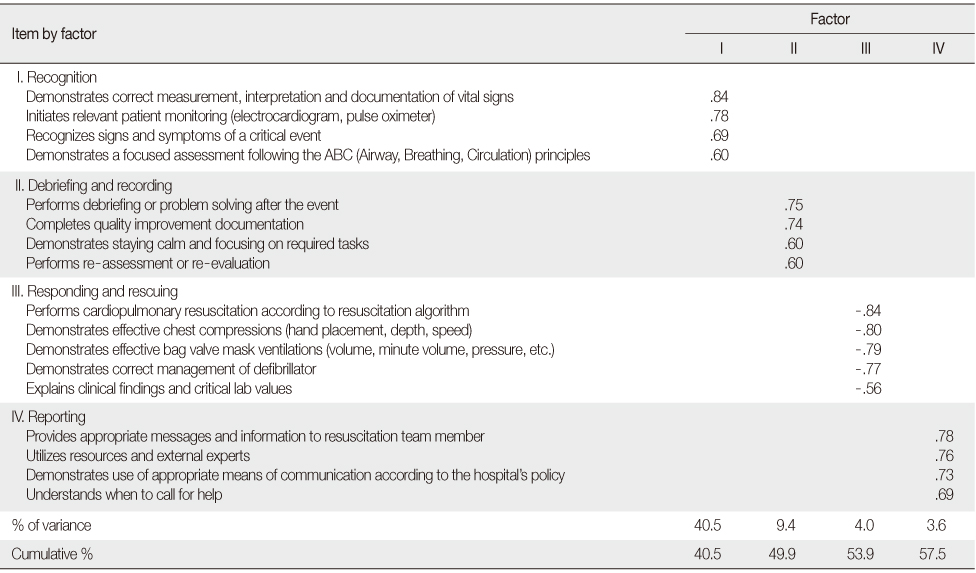Articles
- Page Path
- HOME > J Korean Acad Nurs > Volume 42(7); 2012 > Article
-
Original Article
- Development and Psychometric Evaluation of the Resuscitation Self-efficacy Scale for Nurses
- Young Sook Roh, S. Barry Issenberg, Hyun Soo Chung, So Sun Kim
-
Journal of Korean Academy of Nursing 2012;42(7):1079-1086.
DOI: https://doi.org/10.4040/jkan.2012.42.7.1079
Published online: December 31, 2012
1Red Cross College of Nursing, Chung-Ang University (CAU), CAU Healthcare System, Seoul, Korea.
2Gordon Center for Research in Medical Education, University of Miami Miller School of Medicine, Miami, USA.
3Department of Emergency Medicine, Yonsei University College of Medicine, Seoul, Korea.
4College of Nursing, The Nursing Policy Research Institute, Yonsei University, Seoul, Korea.
- Address reprint requests to: Kim, So Sun. College of Nursing, The Nursing Policy Research Institute, Yonsei University, 50 Yonsei-ro, Seodaemun-gu, Seoul 120-750, Korea. Tel: +82-2-2228-3254, Fax: +82-2-392-5440, soskim@yuhs.ac
© 2012 Korean Society of Nursing Science
- 1,544 Views
- 88 Download
- 24 Crossref
Abstract
-
Purpose
- The purpose of this study was to develop and evaluate psychometric properties of the instrument, Resuscitation Self-Efficacy Scale for nurses.
-
Methods
- This was a methodological study for instrument development and psychometric testing. The initial item pool derived from literature review and experts resulted in 30 items linked to resuscitation self-efficacy. A convenience sample of 509 Korean nurses from eleven academic teaching hospitals participated in a survey to examine psychometric properties of the scale. To examine construct validity, exploratory factor analysis and known-group comparison were used. Cronbach's coefficient alpha was used to determine the scale's internal consistency reliability.
-
Results
- The final scale included 17 items with four-component structure termed 'Recognition', 'Debriefing and recording', 'Responding and rescuing', and 'Reporting'. These four factors accounted for 57.5% of the variance. Each subscale and the total scale demonstrated satisfactory internal consistency: .82; .88; .87; .83; and .91 respectively. Experienced nurses reported significantly higher self-efficacy mean scores in both total and subscales compared to new graduate nurses.
-
Conclusion
- The Resuscitation Self-Efficacy Scale for nurses yields reliable and valid results in appraising the level of resuscitation self-efficacy for Korean nurses. Further study is needed to test and refine the scale.
INTRODUCTION
METHODS
RESULTS
DISCUSSION
CONCLUSION
- 1. Abella BS, Alvarado JP, Myklebust H, Edelson DP, Barry A, O'Hearn N, et al. Quality of cardiopulmonary resuscitation during in-hospital cardiac arrest. JAMA. 2005;293(3):305–310. http://dx.doi.org/10.1001/jama.293.3.305.ArticlePubMed
- 2. Bandura A. Self-efficacy: The exercise of control. 1997;New York, Freeman.
- 3. Cant RP, Cooper SJ. Simulation-based learning in nurse education: Systematic review. J Adv Nurs. 2010;66(1):3–15. http://dx/doi.org/10.1111/j.1365-2648.2009.05240.x.ArticlePubMed
- 4. Carlo WA, Wright LL, Chomba E, McClure EM, Carlo ME, Bann CM, et al. Educational impact of the neonatal resuscitation program in low-risk delivery centers in a developing country. J Pediatr. 2009;154:504–508. http://dx/doi.org/10.1016/j.jpeds.2008.10.005.ArticlePubMed
- 5. Fuhrmann L, Lippert A, Perner A, Østergaard D. Incidence, staff awareness and mortality of patients at risk on general wards. Resuscitation. 2008;77:325–330. http://dx/doi.org/10.1016/j.resuscitation.2008.01.009.ArticlePubMed
- 6. Gordon CJ, Buckley T. The effect of high-fidelity simulation training on medical-surgical graduate nurses perceived ability to respond to patient clinical emergencies. J Contin Educ Nurs. 2009;40:491–498. http://dx/doi.org/10.1016/j.resuscitation.2008.01.009.ArticlePubMed
- 7. Hicks CM, Bandiera GW, Denny CJ. Building a simulation-based crisis resource management course for emergency medicine, phase 1: Results from an interdisciplinary needs assessment survey. Acad Emerg Med. 2008;15:1136–1143. http://dx/doi.org/10.1111/j.1553-2712.2008.00185.x.ArticlePubMed
- 8. Kim EJ, Lee KR, Lee MH, Kim JY. Nurses' cardiopulmonary resuscitation performance during the first 5 minutes in in-situ simulated cardiac arrest. J Korean Acad Nurs. 2012;42(3):361–368. http://dx.doi.org/10.4040/jkan.2012.42.3.361.ArticlePubMed
- 9. Maibach EW, Schieber RA, Carroll MF. Self-efficacy in pediatric resuscitation: Implications for education and performance. Pediatrics. 1996;97:94–99.ArticlePubMed
- 10. May BA, Limandri BJ. Instrument development of the Self-Efficacy Scale for abused women. Res Nurs Health. 2004;27:208–214. http://dx/doi.org/10.1002/nur.20018.ArticlePubMed
- 11. Moretti MA, Cesar LA, Nusbacher A, Kern KB, Timerman S, Ramires JA. Advanced cardiac life support training improves long-term survival from in-hospital cardiac arrest. Resuscitation. 2007;72(3):458–465. http://dx.doi.org/10.1016/j.resuscitation.2006.06.039.ArticlePubMed
- 12. Odell M, Victor C, Oliver D. Nurses' role in detecting deterioration in ward patients: Systematic literature review. J Adv Nurs. 2009;65:1992–2006. http://dx/doi.org/10.1111/j.1365-2648.2009.05109.x.ArticlePubMed
- 13. Pett MA, Lackey NR, Sullivan JJ. Making sense of factor analysis: The use of factor analysis for instrument development in health care research. 2003;London, Sage Publications.
- 14. Pothitakis C, Ekmektzoglou KA, Piagkou M, Karatzas T, Xanthos T. Nursing role in monitoring during cardiopulmonary resuscitation and in the peri-arrest period: A review. Heart Lung. 2011;40:530–544. http://dx/doi.org/10.1016/j.hrtlng.2010.11.006.ArticlePubMed
- 15. Roh YS, Lee WS, Chung HS, Park YM. The effects of simulation-based resuscitation training on nurses' self-efficacy and satisfaction. Nurse Educ Today. 2011;http://dx/doi.org/10.1016/j.nedt.2011.11.008.
- 16. Smith GB. In-hospital cardiac arrest: Is it time for an in-hospital 'chain of prevention'? Resuscitation. 2010;81:1209–1211. http://dx/doi.org/10.1016/j.resuscitation.2010.04.017.ArticlePubMed
- 17. Stump GS, Husman J, Brem SK. The Nursing Student Self-Efficacy Scale: Development using item response theory. Nurs Res. 2012;61(3):149–158. http://dx/doi.org/10.1097/NNR.0b013e318253a750.PubMed
- 18. Travers AH, Rea TD, Bobrow BJ, Edelson DP, Berg RA, Sayre MR, et al. Part 4: CPR overview: 2010 American Heart Association Guidelines for cardiopulmonary resuscitation and emergency cardiovascular care. Circulation. 2010;122:18 Suppl 3. S676–S684. http://dx/doi.org/10.1161/CIRCULATIONAHA.110.970913.PubMed
- 19. Turner NM, Lukkassen I, Bakker N, Draaisma J, ten Cate OT. The effect of the APLS-course on self-efficacy and its relationship to behavioural decisions in paediatric resuscitation. Resuscitation. 2009;80:913–918. http://dx/doi.org/10.1016/j.resuscitation. 2009.03.028.ArticlePubMed
- 20. Turner NM, van de Leemput AJ, Draaisma JM, Oosterveld P, ten Cate OT. Validity of the visual analogue scale as an instrument to measure self-efficacy in resuscitation skills. Med Educ. 2008;42:503–511. http://dx/doi.org/doi:10.1111/j.1365-2923.2007.02950.x.ArticlePubMed
- 21. van Schaik SM, Plant JL, Diane S, Tsang L, O'Sullivan P. Interprofessional team training in pediatric resuscitation: A low-cost, in situ simulation program that enhances self-efficacy among participants. Clin Pediatr (Phila). 2011;50:807–815. http://dx/doi.org/10.1177/0009922811405518.ArticlePubMedPDF
- 22. Wayne DB, Didwania A, Feinglass J, Fudala MJ, Barsuk JH, McGaghie WC. Simulation-based education improves quality of care during cardiac arrest team responses at an academic teaching hospital: A case-control study. Chest. 2008;133(1):56–61. http://dx/doi.org/10.1378/chest.07-0131.ArticlePubMed
REFERENCES
Figure & Data
REFERENCES
Citations

- First aid self-efficacy: a scale adaptation and psychometric properties
Minna Sihvo, Ville Heilala, Tommi Kärkkäinen
BMC Public Health.2025;[Epub] CrossRef - Rapid cycle deliberate practice simulation with standardized prebriefing and video based formative feedback in advanced cardiac life support
Kyungja Kang, Mi Yu
Scientific Reports.2025;[Epub] CrossRef - Validation, Invariance, and Reliability of Instruments for the Assessment of Knowledge and Attitudes Toward Cardiopulmonary Resuscitation in Peruvian Children and Adolescents
Ángel López-González, Joseba Rabanales-Sotos, Yrene E. Urbina-Rojas, Zoila E. Leitón-Espinoza, María D. P. Gómez-Luján, Francisco García-Alcaráz, Walter Capa-Luque
Children.2025; 12(6): 697. CrossRef - Effect of tailored cardiopulmonary resuscitation training for middle-aged and older adults with visual impairment: A cluster-randomized controlled trial
Eunjin Yang, Kyung Hee Lee, Youngshin Joo
Disability and Health Journal.2025; 18(4): 101909. CrossRef - Adaptation of the basic resuscitation skills self-efficacy scale in nursing students to Turkish : a validity and reliability study
Halil Ibrahim Gules, Gulten Sucu Dag
BMC Medical Education.2025;[Epub] CrossRef - Effects of Prebriefing Using Online Team-Based Learning in Advanced Life Support Education for Nurses
Eunkyoung Song, S. Barry Issenberg, Young Sook Roh
CIN: Computers, Informatics, Nursing.2023; 41(11): 909. CrossRef - Determining the mothers’ first-aid self-efficacy in-home accidents in Turkey
Derya Can, Nukhet Bayer
European Journal of Environment and Public Health.2023; 7(3): em0141. CrossRef - Effectiveness of school-based CPR training among adolescents to enhance knowledge and skills in CPR: A systematic review
Nombulelo E. Zenani, Bashir Bello, Matsipane Molekodi, Ushotanefe Useh
Curationis.2022;[Epub] CrossRef - Relationships among Affect, Hardiness and Self-Efficacy in First Aid Provision by Airline Cabin Crew
Yi-Chen Yu, Jyh-Chong Liang
International Journal of Environmental Research and Public Health.2021; 18(4): 2108. CrossRef - The relationship between knowledge and self-efficacy of nurses regarding early initiation of cardiopulmonary resuscitation and automated defibrillation in Saudi Arabia
Zainah D Alaryani, Aisha Alhofaian, Mona Elhady
Belitung Nursing Journal.2021; 7(5): 387. CrossRef - Effectiveness of self-re-learning using video recordings of advanced life support on nursing students’ knowledge, self-efficacy, and skills performance
Kyeongmin Jang, Sung Hwan Kim, Ja Young Oh, Ji Yeon Mun
BMC Nursing.2021;[Epub] CrossRef - Effect of Korean Advanced Life Support Education on Non-Technical and Technical Skills of Nursing Students: A Pilot Study
Yon Hee Seo, Kyong Ah Cho
Healthcare.2021; 9(10): 1253. CrossRef - The Effects of Simulation-Based Advanced Life Support Education for Nursing Students
Sung Hwan Kim, Barry Issenberg, Young Sook Roh
CIN: Computers, Informatics, Nursing.2020; 38(5): 240. CrossRef - Autoeficacia en reanimación cardiopulmonar (RCP) básica y avanzada: diseño y validación de una escala
Susana Navalpotro Pascual, Ángeles Blanco-Blanco, Juan Carlos Torre Puente
Educación Médica.2019; 20(5): 272. CrossRef - Development and Validation of the Pediatric Resuscitation and Escalation of Care Self-Efficacy Scale
Adrian D. Zurca, Nils Olsen, Raymond Lucas
Hospital Pediatrics.2019; 9(10): 801. CrossRef - Development of an instrument for the evaluation of advanced life support performance
L.‐M. Peltonen, V. Peltonen, S. Salanterä, M. Tommila
Acta Anaesthesiologica Scandinavica.2017; 61(9): 1215. CrossRef - HOW DO KNOWLEDGE AND SELF-EFFICACY OF INTERNSHIP NURSING STUDENTS IN PERFORMING CARDIOPULMONARY RESUSCITATION?
Selly Desiani, Aan Nuraeni, Ayu Prawesti Priambodo
Belitung Nursing Journal.2017; 3(5): 612. CrossRef - Influence of Nursing Students’ Anxiety during Simulation Training on Personal Satisfaction of Simulation, Self-efficacy, Clinical Competence
Mi Young Kim, Soohyun Park, Jongsoon Won
Journal of Korean Academy of Fundamentals of Nursing.2016; 23(4): 411. CrossRef - Development and psychometric assessment of the Basic Resuscitation Skills Self-Efficacy Scale
Jose Hernández-Padilla, Fiona Suthers, Cayetano Fernández-Sola, Jose Granero-Molina
European Journal of Cardiovascular Nursing.2016; 15(3): e10. CrossRef - Effects of an integrated simulation-based resuscitation skills training with clinical practicum on mastery learning and self-efficacy in nursing students
Young Sook Roh, Eun Ju Lim, S. Barry Issenberg
Collegian.2016; 23(1): 53. CrossRef - Effects of cardiopulmonary resuscitation reeducation on persistence of knowledge, performance and self-efficacy of nursing students
Myeong-Jeong Chae, Jin-Hee Lee, In-Ja Song, Jin-Il Kim
The Korean Journal of Emergency Medical Services.2015; 19(1): 51. CrossRef - Association of cardiopulmonary resuscitation psychomotor skills with knowledge and self‐efficacy in nursing students
Young Sook Roh, S Barry Issenberg
International Journal of Nursing Practice.2014; 20(6): 674. CrossRef - Effects of High-Fidelity Patient Simulation on Nursing Students’ Resuscitation-Specific Self-Efficacy
YOUNG SOOK ROH
CIN: Computers, Informatics, Nursing.2014; 32(2): 84. CrossRef - The Effect of Computer-Based Resuscitation Simulation on Nursing Students’ Performance, Self-Efficacy, Post-Code Stress, and Satisfaction
Young Sook Roh, Sang Suk Kim
Research and Theory for Nursing Practice.2014; 28(2): 127. CrossRef
- Figure
- We recommend
- Related articles
-
- Development of a communication self-efficacy scale for nurses: a psychometric validation study
- Validity and Reliability of the Korean Version of the Occupational Coping Self-Efficacy Scale for Nurses
- Development and Psychometric Evaluation of the Ischemic Stroke Distress Scale (ISDS)
- Psychometric Properties of the Korean Version of Self-Efficacy for HIV Disease Management Skills
- Development and Validation of a Dignity in Care Scale of Terminally Ill Patients for Nurses

Figure 1
Demographic Profile of Nurses (N=509)
Factor Loadings and Total Variance Explained from the Rotated Factor Structure Matrix for the Resuscitation Self-efficacy Scale (N=509)
Comparison of Self-efficacy Scores between New Graduate and Experienced Nurses (N=509)
*Divided by work duration, new graduate nurses with≤ 12 months, experienced nurses with>12 months.
Factor Correlations and Factor Coefficients for the Resuscitation Self-efficacy Scale (N=509)
*Reliability estimates appear in the parentheses on the diagonal.
*Divided by work duration, new graduate nurses with≤ 12 months, experienced nurses with>12 months.
*Reliability estimates appear in the parentheses on the diagonal.
 KSNS
KSNS
 E-SUBMISSION
E-SUBMISSION





 Cite
Cite

